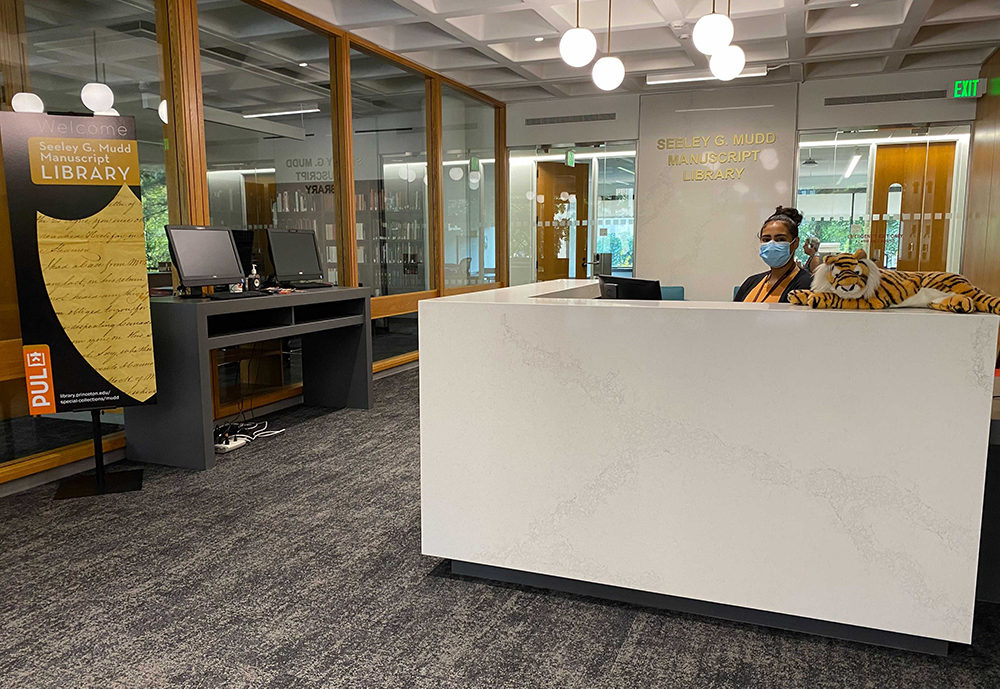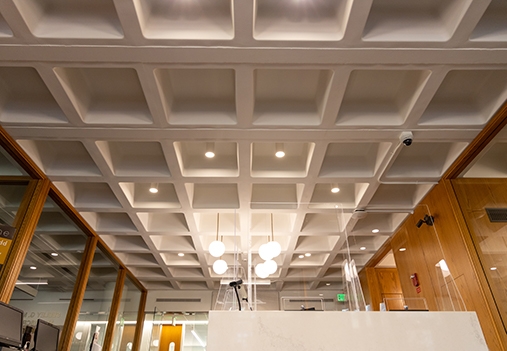Mudd Manuscript Library reopened August 30!

Public Services Project Archivist Amanda Ferrara sits in the lobby of the newly renovated Mudd Manuscript Library. Photo credit: Brandon Johnson
After more than three years of planning, pandemic setbacks, and moving collections out and back, Princeton University Library’s (PUL) Seeley G. Mudd Manuscript Library is reopening its doors to the University community*. Modernizing the building’s fire suppression system was the renovation’s original impetus, but ultimately, many parts of the library were upgraded to provide an additional classroom, more efficient environmental controls, better lighting, enhanced security, and improvements to the electrical and plumbing systems. In addition, new carpeting, paint, and furniture have transformed the feel of the building interior from mid-century modern to a contemporary look.
Mudd houses two major parts of the Library’s Special Collections: the Princeton University Archives and the 20th century public policy papers.
The renovations, which began in 2018, reimagined Mudd’s space with an emphasis on improved service and efficiency. The lobby bisects the first floor – one half of the lobby features two classroom spaces while the other houses the James Forrestal Reading Room. One of the classrooms, the Harlan Room, named for Associate Justice for the U.S. Supreme Court and graduate of the Class of 1920 John Marshall Harlan II, boasts a write-on board as well as a new projector screen. The space between the lobby and the Harlan Room has been reconfigured to create a new seminar room and refreshed exhibition space. The wood framing and doors found in these areas are original from 1976.
Visitors might also notice the updated lobby ceiling, which houses lights in recessed grooves. Assistant University Librarian for Archives & Records Management Anne Marie Phillips explained that while Mudd’s space features new lighting, the renovations kept the existing ceiling intact.
Opposite the Harlan Room sits the Forrestal Reading Room, which shares its namesake with the campus location of the Princeton Plasma Physics Lab, where scholars can view and use materials in a hands-on capacity. “An archivist will be on-site at all times that the Reading Room is open to assist patrons,” Phillips noted.
The lobby itself has also received notable enhancements, with accessibility being a point of emphasis for the redesign. “The most notable physical changes were that the building was fitted with accessible front doors and bathrooms, as well as accessible points at the front desk and public computer stations,” said Phillips.
She added, “We also now have improved accessibility with furniture. As we receive visitors to the building, we will learn more about needs that may not have been addressed during the renovation, and we’ll work to address those as well.”
In addition to accessibility improvements, the lobby features other quality-of-life upgrades. Researchers and students will be able to store their belongings in electronically controlled lockers, and can refill their water bottles at a new refill station.

The renovations kept the ceiling intact while introducing updated lighting. Photo credit: Brandon Johnson.
Though Mudd has traditionally dealt in physical records – manuscripts, photographs, audiovisual materials– the new space and technology allow staff to increase their focus on digitized and born-digital records. There’s a new in-house digitization studio which, according to Assistant University Librarian for Special Collections Public Services Sara Logue, will enhance the work done by Mudd staff to digitize physical materials for researchers.
“While the staff at Mudd Library have always done in-house digitization, the Mudd digital studio, which is essentially a dark room with two distinct spaces equipped with cameras, gives us the opportunity to be in line with the output produced by the digitization lab in Firestone Library,” Logue said.
Additionally, a separate, secure room was created to house equipment used to process born-digital records such as emails and other files that have always existed in electronic form.
Despite the growing importance of electronic materials, the Mudd renovations worked to shrink the Library’s energy footprint.
“When Mudd was built in 1976, it was the first building constructed on campus where energy efficiency was a primary concern,” explained University Archivist and Deputy Head of Special Collections Dan Linke. “With the renovation, the University invested in contemporary energy efficiency upgrades, including new HVAC, better insulated windows, digital temperature controls, and LED lighting. The University’s efforts mean that while the building is preserving the University’s past within, its smaller energy footprint continues to contribute to the future health of the global climate.”
Mudd currently houses 30,000 linear feet of archival and manuscript material, which continues to grow as new records are collected. The on-site storage facility was redesigned with growth in mind, the space meticulously mapped to ensure room for future acquisitions.
“I am particularly excited that our staff used this opportunity to completely revamp our collection organization scheme,” Phillips said. “Because manuscript collections can arrive at Mudd piecemeal, over long periods of time, related materials were not always shelved in adjacent locations. Our staff did extensive planning to ensure that collections were removed in a precise order so that they could be returned to the building in call number order. This not only simplifies retrieval, but conserves shelf space. A win-win!”
*With the 2021-22 Princeton University academic year underway, Mudd Library is open to Princeton University faculty, researchers, and students. As of the start of the fall 2021 semester and in accordance with University policy, visitors will not be allowed to access the physical Mudd space. Would-be visitors can still take advantage of Mudd’s services virtually, through virtual reference, the virtual reading room, as well as direct delivery of born-digital and digitized materials upon request.
“We eagerly await the time when University policy allows us to welcome researchers from outside the Princeton community, and we will be updating our website accordingly,” said Logue. “In the meantime, please feel free to contact us through the Ask Us! form.”
To learn more about the Seeley G. Mudd Manuscript Library, visit the website.
Published on September 01, 2021
Written by: Brandon Johnson, Communications Specialist
Media contact: Barbara Valenza, Director of Library Communications
Newsletter
Subscribe to Princeton University Library’s e-newsletter for the latest updates on teaching and research support, collections, resources, and services.
